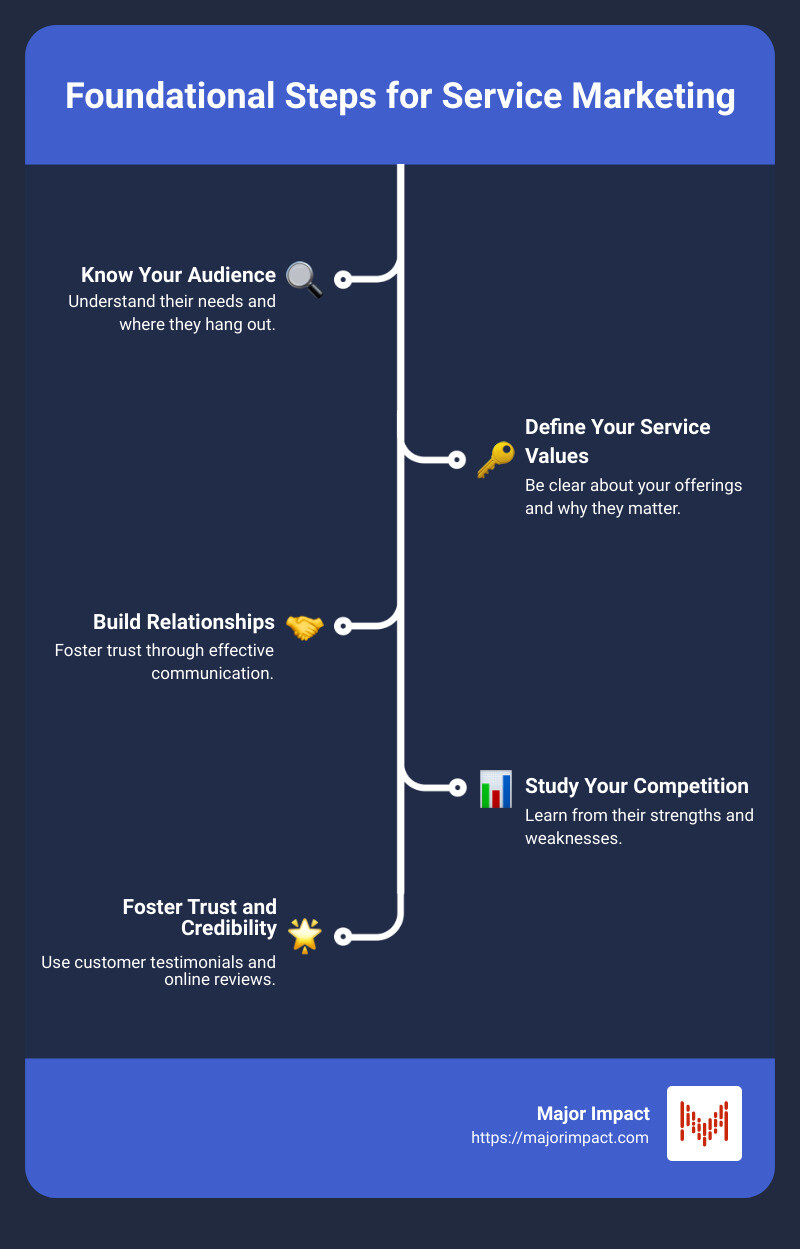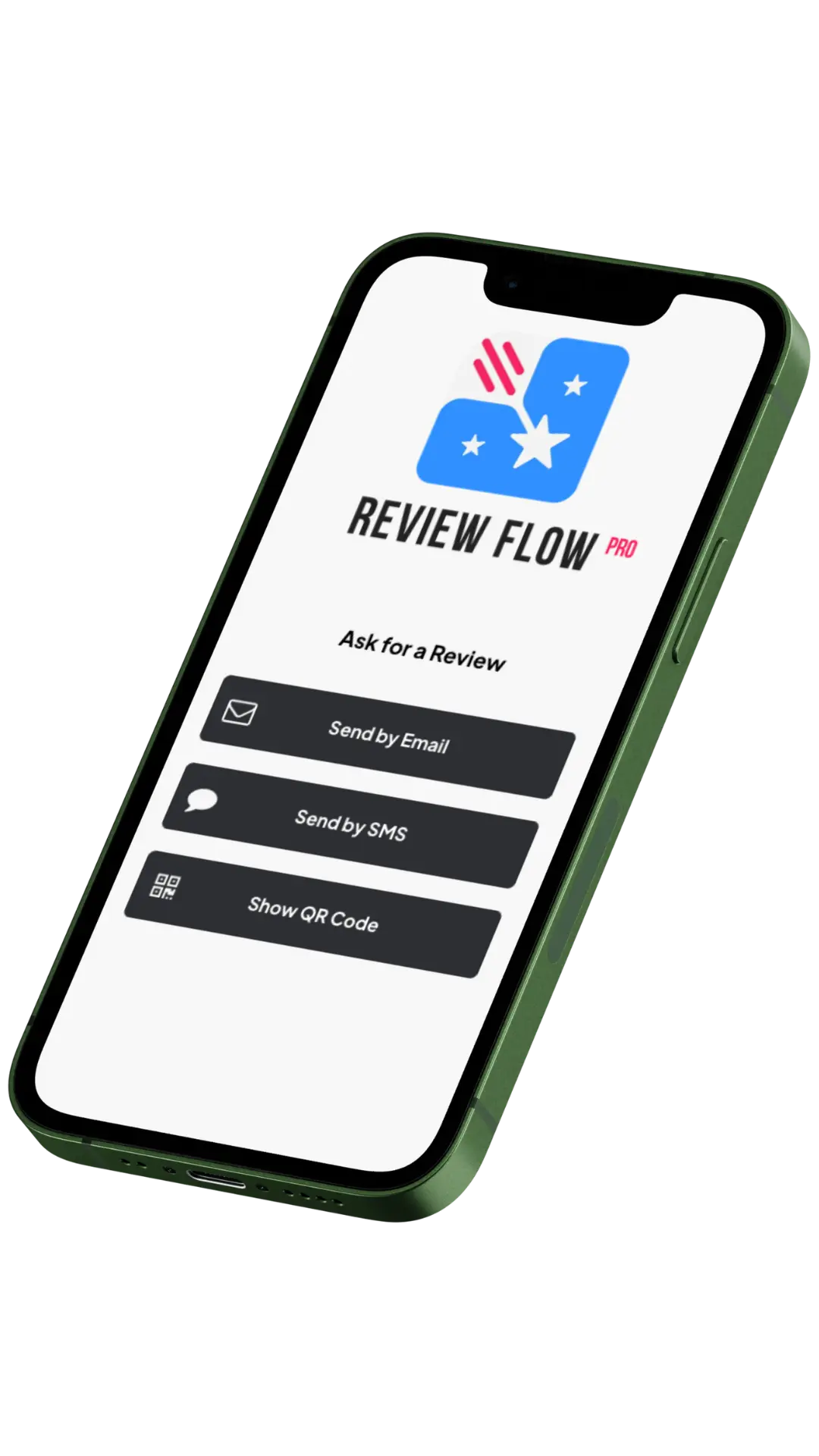Table of Contents
The Importance of Service Marketing Strategies
Marketing a service-based business can feel overwhelming, but it doesn’t have to be. To get you started right away, here are the foundational steps:
- Know Your Audience: Understand their needs and where they hang out.
- Define Your Service Values: Be clear about your offerings and why they matter.
- Build Relationships: Foster trust through effective communication.
- Study Your Competition: Learn from their strengths and weaknesses.
- Foster Trust and Credibility: Use customer testimonials and online reviews.
- Perfect Your Brand Voice: Ensure consistent and relatable messaging.
- Leverage SEO and Social Media: Optimize for search engines and engage on social platforms.
Marketing a service-based business is different from marketing a product because services are intangible, perishable, and often hard to measure. Trust and reputation play huge roles in this field. Companies like Airbnb and Uber have mastered this by leveraging customer reviews and establishing strong vetting processes and safety guarantees.
My name is Elliott Kosmicki, and I have helped generate over 200,000 leads for small businesses across the U.S. Over the years, I’ve learned that the most effective service marketing strategies revolve around building relationships, trust, and a strong brand voice.
Transitioning from understanding these elements to applying them can transform your service business. Let’s dive deeper into how you can implement these strategies for success.
Understanding Service Marketing
Marketing a service-based business comes with unique challenges. Unlike products, services are intangible, perishable, and harder to measure. Let’s break down these characteristics and understand how they shape your marketing strategies.
Intangible
Services are intangible. You can’t see, touch, or try a service before you buy it. This makes building trust essential. Companies like Airbnb and Uber excel here. Airbnb uses customer reviews and stringent vetting processes to create a sense of security. Uber builds trust with built-in reviews and safety guarantees for both riders and drivers.
Key Tip: Use customer testimonials and reviews to build credibility. Highlight positive experiences to reassure potential customers.
Perishable
Services are perishable. Once delivered, they can’t be stored or resold. For example, a missed doctor’s appointment is a lost opportunity. This means you need to stay top of mind for your customers. Regular follow-ups and reminders can help keep your business relevant.
Example: An HVAC service can remind customers about seasonal maintenance with a timely email: “It’s been a year since your last HVAC check-up. Schedule your service now and enjoy a 10% discount!”
Non-Measurable
You can’t measure a service like a product. There are no dimensions or weights. This makes it harder for customers to evaluate the value they’re getting. For instance, how do you measure the quality of legal advice or a massage?
Solution: Use customer testimonials and reviews to provide social proof of your service’s value. Highlight specific outcomes and benefits.
No Ownership Transfer
When you sell a service, there’s no transfer of ownership. A customer pays for a service but doesn’t own it. For example, a patient pays for a doctor’s visit but doesn’t own the doctor’s expertise or equipment.
Focus: Emphasize the experience and outcomes rather than ownership. Highlight the benefits and results your service provides.
People Involvement
People are a critical part of service delivery. The quality of your service often depends on the skills and attitudes of your staff. This makes hiring and training crucial.
Challenge: Maintaining consistent quality can be tough. Each service provider may have different skills, and external factors can affect the interaction.
Example: HubSpot offers a full stack of software for content, social media, marketing, sales, and customer service. They focus on training and empowering their staff to provide excellent service consistently.
Variable Quality
Service quality can vary. Unlike products, services are delivered by people, and human factors can lead to inconsistencies. This variability can affect customer satisfaction.
Strategy: Implement standard operating procedures and continuous training programs to ensure consistent service quality. Use customer feedback to identify areas for improvement.
Case Study: Uber works on building credibility and trust by implementing driver screenings and safety tools. This helps maintain a consistent service quality and enhances customer satisfaction.
Understanding these unique characteristics of service marketing can help you develop effective strategies. Next, we’ll dive into specific tactics to build trust and leverage customer testimonials.
10 Targeted Strategies for Marketing Services
Marketing a service-based business requires unique approaches that build trust, highlight your expertise, and retain loyal customers. Here are 10 targeted strategies to help you stand out:
1. Build Trust
Trust is the cornerstone of any service business. Customers need to feel confident that you can deliver on your promises.
Strategy: Showcase customer reviews and testimonials prominently on your website. Highlight any industry certifications or safety guarantees you offer.
Case Study: Uber builds trust with rider and driver safety guarantees, such as driver screenings and safety tools. This practice has helped them maintain a loyal customer base and attract new users.
2. Leverage Customer Testimonials
Social proof is powerful. People trust the opinions of others, especially those who have used your services.
Strategy: Collect and display customer testimonials and reviews on your website and social media profiles. Encourage satisfied customers to leave reviews.
Example: Airbnb uses customer reviews and stringent vetting processes to create a sense of security and reliability.
3. Highlight Awards and Badges
Verification from third parties adds credibility to your business.
Strategy: Display any awards, badges, or industry recognitions on your website and marketing materials.
Example: Yoga therapist Simchah Huizar uses her website to tell her story and express her distinctive approach, which includes sharing her qualifications and unique selling points.
4. Define and Communicate Your Unique Selling Point (USP)
Your unique selling point (USP) sets you apart from the competition. It’s not just about what you offer, but also who you are.
Strategy: Clearly communicate your USP on your website and in all marketing materials. Make it personal and relatable.
Example: Simchah Huizar combines yoga with her Christian faith, making her approach unique and appealing to a specific audience.
5. Personalize Your Services
Customization can make your service more appealing to a broader audience.
Strategy: Offer flexible options that cater to different needs and budgets. Highlight this flexibility in your marketing.
Example: Total Dog! Dog Training Solutions tailors its services to meet the specific needs of each dog and owner, which is clearly communicated on their website.
6. Retain Existing Customers
Customer retention is often more cost-effective than acquiring new customers.
Strategy: Use email marketing to keep in touch with existing customers. Send personalized offers and ask for feedback to improve your services.
Tip: Use tools like Orderry to manage and process customer leads efficiently.
7. Provide Extraordinary Customer Service
Exceptional customer service can turn customers into brand advocates.
Strategy: Train your team to go above and beyond in customer interactions. Address any issues promptly and effectively.
Fact: Companies that excel in customer service can see up to a 70% increase in revenue from referrals.
8. Facilitate Online Bookings
Convenience is key for customers.
Strategy: Implement an easy-to-use online booking system. Offer free consultations to attract new clients.
Example: Many successful service businesses use online scheduling tools to streamline the booking process and improve customer satisfaction.
9. Create Strategic Content
Content creation helps you establish authority and attract organic traffic.
Strategy: Regularly publish blog posts, social media updates, and videos that address common customer pain points and showcase your expertise. Optimize this content for search engines (SEO).
10. Offer Welcome Deals and Referral Perks
Incentives can attract new customers and encourage existing ones to refer others.
Strategy: Create special offers for new customers and referral programs that reward existing customers for bringing in new business.
Example: Many local businesses offer discounts for first-time clients or loyalty programs to keep customers coming back.
By implementing these strategies, you can effectively market your service-based business and build a loyal customer base. Next, we’ll explore digital marketing strategies tailored for service businesses.
1. Build Trust
Building trust is the cornerstone of marketing a service-based business. Trust leads to customer loyalty and satisfaction, which are critical for long-term success.
Why Trust Matters
Unlike products, services are intangible. Customers can’t see or touch what they’re buying. This makes trust even more essential. When customers trust your business, they are more likely to choose your services over competitors.
How to Build Trust
1. Showcase Customer Testimonials
Customer testimonials are powerful. They provide social proof that your service delivers on its promises. According to a Forbes article, video testimonials can be particularly compelling.
Example: Diego Orjuela from Cables & Sensors emphasizes the importance of video testimonials. He suggests that these videos build trust by showing real customer experiences.
2. Highlight Awards and Badges
Awards and badges are visible proof of your credibility and expertise. Displaying them prominently on your website and marketing materials can make a significant impact.
Example: If your business has been voted the “Best Local Service” in your area, showcasing this badge can immediately build trust with potential customers.
3. Leverage Customer Reviews
Positive reviews on platforms like Google can significantly impact your reputation. Use a review management tool to collect and showcase these reviews.
Pro Tip: Tools like Orderry can automate customer review collection, making it easier to gather and display feedback.
Building Customer Loyalty
1. Offer Consistent Quality
Consistency is key. Customers need to know they can rely on you to deliver the same high-quality service every time.
2. Engage with Your Customers
Be active on social media and engage with your audience. Respond to comments, share useful content, and show that you are approachable.
Example: Commerce Bank uses simple recruiting criteria like “Does this person smile in a resting state?” to ensure friendly service, which builds trust with customers.
Ensuring Customer Satisfaction
1. Respond to Feedback
Always respond to customer feedback, whether positive or negative. This shows that you value their input and are committed to improving your service.
Example: Josh Kohlbach from Wholesale Suite highlights the importance of responding to all calls, emails, and social media messages regularly.
2. Showcase Success Stories
Regularly update your website and social media with success stories and case studies. This not only builds trust but also demonstrates the value of your services.
Example: Total Dog! uses their website to explain their training process clearly, addressing customer doubts in a comprehensive FAQ section.
Conclusion
Building trust with your audience is essential for the success of your service business. Use customer testimonials, awards, and social proof to establish credibility and foster trust.
Next, we’ll dive into Digital Marketing Strategies for Service-Based Businesses to further enhance your business’s reach and impact.
2. Leverage Customer Testimonials
Social proof plays a vital role in marketing a service-based business. Customer testimonials and reviews offer tangible evidence that others have benefited from your services. This helps build trust with potential clients who are considering your offerings.
Why Social Proof Matters
Social proof is the idea that people will follow the actions of others. When potential clients see positive reviews and testimonials, they are more likely to trust your service. According to Forbes, 97% of consumers use online reviews to search for local services.
Collecting Customer Feedback
Ask for Feedback: After completing a service, request feedback from your customers. A simple email or survey can work wonders.
Timing Matters: Ask for reviews when the experience is fresh in the customer’s mind. This increases the chances of receiving detailed and positive feedback.
Make It Easy: Provide a direct link to your review page. The easier it is for customers to leave a review, the more likely they are to do it.
Managing Reviews
Monitor Reviews: Regularly check platforms like Google Reviews, Yelp, and social media for new reviews. Responding promptly shows you care about customer feedback.
Respond to All Reviews: Whether the review is positive or negative, always respond. Thank customers for positive reviews and address any issues mentioned in negative reviews.
“Responding to reviews is an opportunity to show customers (current or potential) that you care about their experience with your company.” — Amanda Putney, Portent
Highlight Positive Reviews: Share glowing reviews on your website and social media. This not only boosts your credibility but also encourages other customers to leave their feedback.
Case Study: Total Dog!
Total Dog! creatively frames customer testimonials with their fun brand personality. They use “5-paw reviews” from pet owners, including photos of their canine clients. This unique approach not only showcases their happy customers but also aligns with their brand identity.
Importance of Google Reviews
Boost SEO: Google Reviews can significantly impact your local SEO. More positive reviews can help you rank higher in local search results.
Build Trust: Reviews on Google are highly visible and trusted by consumers.
Use Tools: Platforms like Orderry can automate the review collection process, making it easier to gather and manage customer feedback.
Example: A local golf simulator business used Google Reviews to climb the rankings. Initially, they couldn’t be found on Google Maps. After focusing on collecting and managing reviews, they ranked in the top 3 in their town within two months.
By leveraging customer testimonials and reviews, you can build a strong reputation and attract more clients.
Next, we’ll dive into Digital Marketing Strategies for Service-Based Businesses to further enhance your business’s reach and impact.
3. Highlight Awards and Badges
Awards and badges are powerful tools for building credibility and trust with your audience. They serve as visible proof of your expertise and reliability. Here’s how to leverage them effectively:
Verification
Getting your business verified on platforms like Google My Business is a crucial first step. Verified profiles are more likely to appear in local search results, making it easier for potential customers to find you.
Pro Tip: Regularly update your profile information to maintain your business’s legitimacy and keep your clients informed.
Credibility
Awards and badges from reputable organizations can significantly boost your credibility. Display them prominently on your website, social media, and marketing materials.
Example: If your business has been voted “Best Local Service” in your area, showcase that badge on your homepage. This not only builds trust but also sets you apart from competitors.
Industry Recognition
Industry awards are a great way to gain recognition and showcase your expertise. They signal to potential clients that your service is top-notch and trusted by industry peers.
Example: HubSpot highlights their certifications and user statistics as part of their marketing strategy. This approach not only builds credibility but also demonstrates their industry leadership.
Pro Tip: Don’t just win awards; talk about them. Share your achievements on social media, in newsletters, and during client meetings.
Commerce Bank is a great example of how to use simple criteria like “Does this person smile in a resting state?” to ensure friendly service, which builds trust with customers.
By highlighting awards and badges, you can enhance your reputation and attract more clients.
Next, we’ll dive into Digital Marketing Strategies for Service-Based Businesses to further enhance your business’s reach and impact.
4. Define and Communicate Your Unique Selling Point (USP)
Your Unique Selling Point (USP) is what sets your service apart from the competition. It’s the special value you offer that no one else does. Defining and communicating your USP effectively can help you attract and retain customers.
Why is a USP Important?
A strong USP tells potential customers why they should choose your service over others. It highlights your value proposition and shows how you solve their problems in a unique way.
Example: Yoga therapist Simchah Huizar combines yoga with her Christian faith, providing a unique and accessible approach to yoga. Her website showcases this distinct blend, helping her stand out in a crowded market.
Steps to Define Your USP
1. Identify Your Strengths: What do you do better than anyone else? This could be your expertise, a special technique, or exceptional customer service.
2. Know Your Audience: Understand the needs and desires of your target market. Tailor your USP to address their specific pain points.
3. Analyze Competitors: Look at what your competitors are offering. Find gaps in their services and position your USP to fill those gaps.
4. Craft Your Message: Make your USP clear, concise, and compelling. Use simple language to explain why your service is the best choice.
Communicating Your USP
Once you’ve defined your USP, the next step is to communicate it effectively.
1. Use Your Website: Your website is a powerful tool for showcasing your USP. Include it on your homepage, in the “About Us” section, and throughout your content.
Example: Total Dog! Dog Training Solutions uses its website to clearly explain the outcomes of their training programs, helping to dispel customer uncertainty.
2. Leverage Social Media: Share stories, testimonials, and case studies that highlight your unique value. Engage with your audience and answer their questions to build trust.
3. Email Marketing: Use email campaigns to remind customers of your unique benefits. Offer exclusive insights or tips that reinforce your USP.
4. Visual Content: Use photos, videos, and infographics to make your USP visually appealing. Show how your service works and the benefits it provides.
Example: Simchah Huizar’s website features photos of her in yoga poses, reflecting her casual and accessible approach to yoga.
Real-World Examples
Commerce Bank: They hire for attitude and train for service, ensuring friendly and efficient service. This simple yet effective approach is a key part of their value proposition.
Uber: Uber’s core value is flexibility for both riders and drivers. They build credibility with rider reviews and trust with safety guarantees.
Summary
Defining and communicating your USP is crucial for differentiating your service in a competitive market. Focus on what makes you unique, understand your audience, and use various channels to share your message.
Next, we’ll explore Digital Marketing Strategies for Service-Based Businesses to further enhance your business’s reach and impact.
5. Personalize Your Services
Personalization is a game-changer in marketing a service-based business. Unlike products, services can be tailored to meet specific customer needs, making customization a powerful tool to win over clients.
Customization
Customization means adjusting your services to match individual client preferences. This could be as simple as offering personalized recommendations or as complex as creating entirely bespoke solutions.
Example: Yoga therapist Simchah Huizar tailors her sessions by integrating her Christian faith, making her service unique and appealing to a specific audience. This level of customization helps build a strong connection with clients.
Flexibility
Flexibility is another crucial aspect. Customers appreciate when a business can adapt to their schedules, budgets, and specific needs. This flexibility can be a significant selling point.
Case Study: Total Dog! Dog Training Solutions offers various training packages to suit different needs and budgets. Their website clearly outlines these options, helping clients choose the best fit for their dogs.
Tailored Solutions
Offering tailored solutions means going a step further than customization. It involves understanding the client’s unique problems and crafting solutions specifically for them.
Quote: Marcus Lemonis, host of “The Profit,” often says, “People, process, and product.” In service marketing, the process and people are essential. Tailoring your process to meet client needs can set you apart from competitors.
Practical Tips
- Communicate Often: Keep clients in the loop about how their customized service is progressing. Use emails, phone calls, or even social media updates.
- Clarify Expectations: Make sure both you and the client have a clear understanding of what the service will entail.
- Set Realistic Boundaries: While flexibility is key, it’s important to set limits to ensure quality and manage client expectations.
Tools for Personalization
- CRM Systems: Use Customer Relationship Management (CRM) tools to keep track of client preferences and tailor your services accordingly.
- Feedback Loops: Regularly ask for client feedback to improve and further personalize your services.
Example: HubSpot’s CRM allows businesses to track customer interactions and tailor follow-up services, enhancing client satisfaction.
Conclusion
Personalizing your services not only meets but often exceeds customer expectations. It builds stronger relationships and encourages repeat business. Next, we’ll dive into Digital Marketing Strategies for Service-Based Businesses to further enhance your business’s reach and impact.
6. Retain Existing Customers
Customer Retention
Keeping existing customers is much cheaper than getting new ones. According to research, it costs 5 to 25 times more to attract a new customer than to keep an existing one. This is especially true for service-based businesses, where customers can easily switch to a competitor.
Email Marketing
Email marketing is a powerful tool for customer retention. It helps keep your brand top of mind and provides valuable updates to your customers.
- Build an Email List: Offer incentives like discounts or exclusive content to encourage sign-ups.
- Send Newsletters: Regularly update your audience about new services, promotions, and company news.
- Personalize Emails: Use customer data to tailor emails. For example, if a customer recently used your service, send them tips on how to maintain the benefits.
Example: Landcafe.pl increased their sales rate by 41.30% through educational welcome emails.
Feedback
Customer feedback is gold. It helps you understand what you’re doing right and where you need to improve.
- Collect Reviews: Ask satisfied customers to leave reviews. According to BrightLocal, 97% of consumers use reviews to find local services.
- Respond to Feedback: Address both positive and negative feedback promptly. This shows that you value your customers’ opinions and are committed to improving.
Pro Tip: Use tools like Orderry to automate customer review collection. This system sends requests when clients are most likely to respond, making it easier to gather valuable feedback.
Example: Total Dog!
Total Dog! uses Texas-specific content in their blog to boost local SEO. They also feature “5-paw reviews” from pet owners, creatively framing testimonials with their fun brand personality. This not only builds trust but also keeps customers engaged and coming back.
By focusing on customer retention through email marketing and feedback, you can build a loyal customer base that keeps coming back for more. Next, we’ll explore Digital Marketing Strategies for Service-Based Businesses to further enhance your business’s reach and impact.
7. Provide Extraordinary Customer Service
Great customer service is the backbone of any successful service-based business. It builds trust, encourages repeat business, and generates word-of-mouth referrals.
The Service Recovery Paradox
Even the best businesses sometimes make mistakes. When this happens, you have an opportunity to turn a dissatisfied customer into a loyal one. This is known as the service recovery paradox.
If a customer complains, see it as a chance to shine. Respond promptly, apologize sincerely, and offer a solution. For example, if a customer at your yoga studio mentions a scheduling issue, you could offer a free class as compensation. Handling problems well can make customers feel valued and more loyal than before the issue arose.
Word-of-Mouth Marketing
Satisfied customers love to share their experiences. This word-of-mouth marketing is incredibly powerful and cost-effective.
Encourage happy clients to leave reviews and share their stories. For instance, Total Dog! showcases “5-paw reviews” from pet owners, complete with photos of their canine clients. This creative approach not only builds trust but also aligns with their brand’s fun personality.
Real-Life Examples
Uber excels in customer service by integrating safety measures and incident response teams. This not only builds trust but also ensures a positive experience for both riders and drivers.
HubSpot focuses on convenience and self-service, making it easy for customers to set up and manage their marketing activities. Their customer service team is also highly responsive, which enhances their credibility and customer satisfaction.
By providing extraordinary customer service, you can turn every interaction into a positive experience, fostering loyalty and encouraging referrals. Next, let’s delve into Digital Marketing Strategies for Service-Based Businesses to further enhance your reach and impact.
8. Facilitate Online Bookings
Online Scheduling
Online scheduling can make a huge difference for both you and your customers. When clients can book appointments online, it removes a lot of the friction in the booking process. It’s convenient and quick, which is exactly what people want.
Example: Simchah offers free 15-minute consultations through an online booking system. This makes it super easy for new clients to schedule a time that works for them, reducing barriers to entry.
Using an online scheduling app can also help you manage your time better. You’ll spend less time answering calls and emails and more time focusing on your service.
Free Consultations
Offering free consultations is another excellent way to attract new clients. It gives them a risk-free way to try out your services and see if you’re a good fit. This can be especially important for services that require a significant financial commitment.
Example: A local gym might offer a free one-week trial. This not only gives potential customers a taste of what they can expect but also builds trust.
Convenience
Convenience is key in today’s world. If your booking process is easy and hassle-free, you’re more likely to attract and retain customers. An online booking system provides this convenience, making it easier for customers to choose you over competitors who might still rely on phone calls or emails for scheduling.
Fact: According to a study by Wyzowl, 96% of people have watched a video to learn more about a product or service. Adding video explanations to your online booking page can make it even easier for potential clients to understand what you offer.
By facilitating online bookings, you make it easier for clients to take that first step and increase the likelihood of them choosing your service. Next, let’s dive into Digital Marketing Strategies for Service-Based Businesses to further enhance your reach and impact.
9. Create Strategic Content
Creating strategic content is key to marketing a service-based business. It keeps your brand top of mind, builds trust, and draws in potential clients. Here’s how you can do it effectively:
Blogging
Blogging is a powerful tool for service businesses. It helps you build relationships with clients and improve your search engine rankings.
- Consistency: Post regularly to keep readers engaged.
- SEO Optimization: Use relevant keywords to improve search engine rankings.
- Visuals: Include images and videos to make your posts more engaging.
For example, Total Dog! uses their blog to share valuable content for dog owners, which also improves their local SEO by including Texas-specific content.
“Blogging is also an ideal search engine optimization (SEO) tool.” – Harvard Business Review
Social Media
Social media platforms are essential for engaging with your audience. They help you build and maintain customer relationships.
- Engaging Posts: Share entertaining and informative content.
- Paid Advertising: Consider PPC advertising on platforms like Facebook for a high return on investment.
- Outsourcing: If short on time, consider hiring a marketing agency.
For example, Uber uses social media not only to connect with riders and drivers but also to build credibility and trust through reviews and safety guarantees.
Offer Valuable Content
Providing valuable content helps you showcase your expertise and build trust.
- Problem-Solving: Offer solutions to common problems your audience faces.
- Gated Content: Use gated content like ebooks to build an email list.
For example, Simchah offers a gated ebook that’s only available to people who sign up for her newsletter, helping to build her email list.
Post Videos
Video content is incredibly persuasive. A survey by Wyzowl found that 89% of people were persuaded to buy a product or service after watching a video.
- Tutorials: Show how your service works.
- Customer Testimonials: Share success stories from satisfied clients.
- Platforms: Post videos on YouTube, social media, or your website.
“91% of respondents wanted to see more video content from their favorite brands.” – Wyzowl Survey
By creating strategic content, you can establish your business as a trusted authority, attract more customers, and build lasting relationships. Next, let’s explore Digital Marketing Strategies for Service-Based Businesses to further enhance your reach and impact.
10. Offer Welcome Deals and Referral Perks
Offering welcome deals and referral perks can be a game-changer for marketing a service-based business. These strategies not only attract new customers but also encourage existing ones to spread the word. Here’s how you can do it effectively:
Welcome Deals
Welcome deals are a fantastic way to lower the entry barrier for new clients. These special offers can make potential customers more likely to try your service.
- Discounts: Offer a percentage off the first service or a flat-rate discount. For example, a local spa might offer 20% off for first-time visitors.
- Free Initial Consultations: Give potential clients a taste of your expertise. A business consultant, for example, might offer a free one-hour consultation.
- Bundled Services: Create package deals for initial services. A cleaning service might offer a discounted rate for the first three cleanings.
Referral Perks
Referral marketing leverages the power of word-of-mouth. Happy customers can be your best marketers.
- Rewards for Referrals: Offer discounts or free services to clients who refer new customers. For instance, give a free session to a yoga student who brings a friend.
- Loyalty Programs: Create a points system where customers earn rewards for each referral. This not only incentivizes referrals but also keeps clients coming back.
“Clients who have been referred to you are more loyal, bring in more profit, and stay with your brand longer than those who haven’t.” – Research
Loyalty Programs
Loyalty programs keep customers engaged and encourage repeat business.
- Point Cards: Offer points for each service that can be redeemed for discounts or free services.
- Exclusive Discounts: Provide special offers to loyal customers. For example, a salon might offer a 10% discount after every five visits.
- Member-Only Perks: Create a VIP program with exclusive benefits, like early access to new services or priority booking.
By implementing these strategies, you can attract new clients and turn your existing customers into brand ambassadors.
Next, let’s explore Digital Marketing Strategies for Service-Based Businesses to further enhance your reach and impact.
Digital Marketing Strategies for Service-Based Businesses
Navigating the digital landscape can be tricky, especially when you’re marketing a service-based business. But with the right strategies, you can attract more clients and grow your business effectively. Here are some key tactics to consider:
Website Optimization
Your website is often the first impression potential clients get of your business. Make sure it’s a good one.
- Clear Service Descriptions: Use your website to explain how your service works. For instance, Total Dog! Dog Training Solutions uses a “How It Works” section to guide potential customers through the training process.
- SEO: Optimize your site for search engines. This means using relevant keywords, improving site speed, and ensuring mobile-friendliness. For example, Rue Eiffel improved its local SEO by correcting inconsistencies in its address listings, which led to better search rankings and increased foot traffic.
- User Experience: Make your website easy to navigate. Include FAQs to address common questions and concerns, just like Total Dog! does.
Social Media Marketing
Social media platforms like Facebook, Instagram, and LinkedIn are powerful tools for engaging with your audience.
- Content Creation: Share valuable and engaging content. Simchah Huizar, a yoga therapist, uses her website to tell her story and connect with her audience.
- Paid Ads: Use paid social media marketing channels like Facebook Ads to reach a broader audience. Targeted ads can show your services to people who are already interested in similar offerings.
- Engagement: Respond to comments and messages to build a community around your brand. This helps in maintaining customer relationships and building trust.
PPC Advertising
Pay-Per-Click (PPC) advertising allows you to place ads on search engines and pay only when someone clicks on them. This can provide immediate visibility and drive targeted traffic to your site.
- Google Ads: Reach a vast audience and appear in Google search results. A small bakery in Phoenix used Google Ads to promote its new line of gluten-free products, resulting in a 30% increase in online orders.
- A/B Testing: Use A/B testing to optimize your ad copy and landing pages for better conversion rates. This helps in understanding what works best for your audience.
Email Marketing
Email marketing is a cost-effective way to nurture leads and retain customers.
- Build Your List: Use opt-in forms on your website, social media, and other channels to collect email addresses. Offering incentives like discounts or free guides can help grow your list quickly.
- Segment Your Audience: Divide your email list into smaller segments based on specific criteria like location, past purchase behavior, or service type. This allows for more personalized and effective emails.
- Engaging Content: Craft emails that are engaging and valuable to your audience. Include tips, news, or special offers relevant to their interests.
By implementing these digital marketing strategies, you can improve your website traffic, generate more leads, and increase sales.
Next, we’ll discuss The Importance of Communication in Service Marketing to keep your clients informed and engaged.
The Importance of Communication in Service Marketing
Effective communication is crucial in marketing a service-based business. It helps keep your customers informed, builds trust, and enhances their overall experience. Here are key aspects to consider:
Communication Channels
Establishing clear communication channels is vital. Customers expect to be kept in the loop about your services. Here are some channels you can use:
- Email Updates: Regularly update your customers on the progress of your service.
- Phone Calls: Sometimes a personal touch can make a big difference.
- Designated Software Tools: Tools like Slack or project management software can streamline communication.
- Social Media Platforms: Use platforms like Facebook, Twitter, and LinkedIn to engage with your customers.
Using multiple channels ensures that you can reach your customers in the way they prefer.
Customer Updates
Keeping your customers updated is not just a courtesy; it’s a necessity. Regular updates help manage expectations and reduce anxiety. Here’s how to do it effectively:
- Set Clear Expectations: From the start, let your customers know how and when they will receive updates.
- Regular Progress Reports: Send out regular updates on the status of the service. This can be through emails, phone calls, or even SMS.
- Milestone Notifications: Inform customers when significant milestones are reached.
For example, Marcus Lemonis, host of The Profit, emphasizes the importance of clear communication to keep customers informed and satisfied.
Social Media Engagement
Social media is a powerful tool for engaging with your customers. It allows for real-time interaction and can significantly enhance customer experience. Here’s how to leverage it:
- Share Behind-the-Scenes Content: Give your audience a peek into your process. This builds transparency and trust.
- Respond to Comments and Messages: Engage with your audience by answering their questions and acknowledging their feedback.
- Post Regular Updates: Keep your followers informed about new services, promotions, and company news.
A great example is Airbnb, which uses social media to engage with both travelers and listing owners, enhancing their overall service experience.
By focusing on effective communication, you can ensure that your customers feel valued and informed. This builds trust and can lead to increased customer loyalty and satisfaction.
Next, we’ll dive into Frequently Asked Questions about Marketing a Service-Based Business to address common concerns and provide additional insights.
Frequently Asked Questions about Marketing a Service-Based Business
How do you market a service-based business?
Marketing a service-based business is unique because you’re selling an experience, not a physical product. Here are some key strategies:
Subscriptions: Offering subscription services can help ensure steady revenue. Think of monthly gym memberships or software subscriptions. This model keeps customers engaged over a longer period and makes it easier to predict income.
Referrals: Encourage your satisfied customers to refer friends and family. Word-of-mouth is powerful, especially for local businesses. Offer incentives like discounts or free services for successful referrals.
Customer Retention: It’s often cheaper to keep an existing customer than to acquire a new one. Use email marketing to keep in touch with your customers. Send them updates, special offers, and personalized messages to make them feel valued.
What are the 5 P’s of service marketing?
The 5 P’s of service marketing help you structure your strategy:
Product: This is your service. Clearly define what you offer and how it benefits your customers. For example, a hotel might offer luxurious rooms, spa services, and fine dining.
Price: Set a competitive price that reflects the value of your service. Consider what your competitors are charging and how your service stands out.
Place: This is where your service is delivered. It could be online, at a physical location, or both. Make sure it’s convenient for your customers.
Promotion: Use various methods to advertise your service. This includes SEO, social media, and email marketing. Highlight your unique selling points and customer testimonials.
People: Everyone involved in delivering your service. Train your staff to provide excellent customer service. Their interaction with customers can make or break your business.
What is an example of service-based marketing?
Hotel Promotions: Hotels often use service-based marketing to attract and retain customers. For instance, they might offer special weekend packages, loyalty programs, and discounts for early bookings.
Customer Incentives: Offering incentives like free consultations or welcome deals can attract new customers. For example, a spa might offer a free first massage or a discount on the second visit to encourage repeat business.
By focusing on these strategies, you can effectively market your service-based business and build a loyal customer base.
Conclusion
Marketing a service-based business can be challenging, but it’s also incredibly rewarding. Unlike product marketing, where you can showcase a tangible item, service marketing requires you to build trust and credibility. You’re essentially selling a promise, and that means your reputation is everything.
Key Takeaways
1. Build Trust and Credibility:
Trust is the cornerstone of any service-based business. Collect and showcase customer reviews and testimonials. Encourage satisfied clients to share their experiences. This social proof can significantly influence potential customers. 97% of consumers use reviews to search for local services.
2. Leverage Strategic Marketing:
Use a mix of strategies to reach your audience. Optimize your online presence with SEO, leverage social media, and implement email marketing campaigns. Content creation, such as regular blogging and video posts, can keep your brand top-of-mind. For instance, HubSpot’s content strategy has been pivotal in establishing its credibility and attracting a broad audience.
3. Personalize Customer Experiences:
Tailor your services to meet individual customer needs. Personalized service not only improves customer satisfaction but also fosters loyalty. Uber’s model of flexibility for both riders and drivers is a great example of how personalization can enhance user experience.
4. Offer Incentives and Deals:
Welcome deals and referral perks can attract new clients and retain existing ones. For example, a spa might offer a free first massage or a discount on the second visit to encourage repeat business.
Thank you for reading our guide on how to market a service-based business effectively. We hope these strategies help you succeed this year and beyond.
Good luck!








